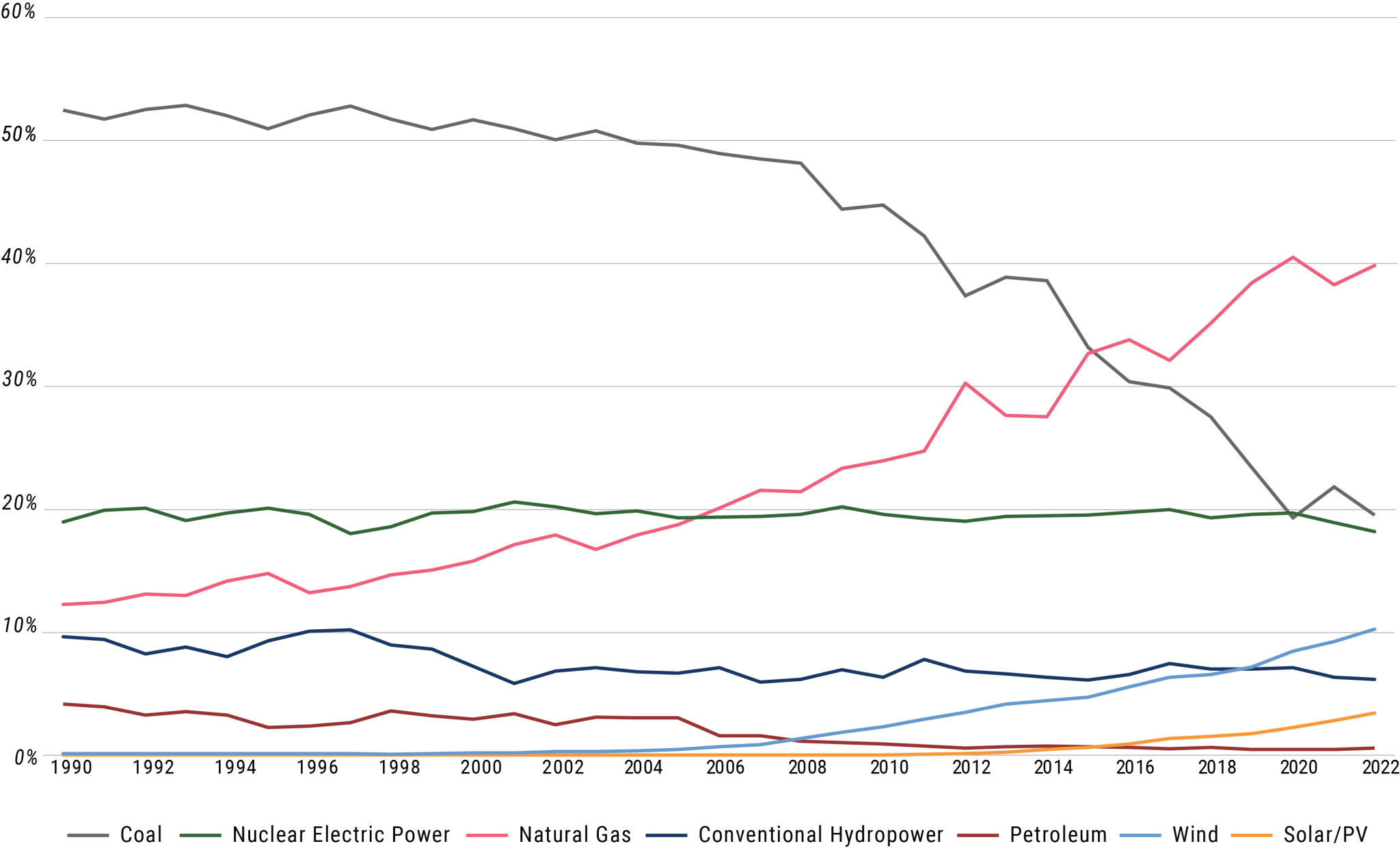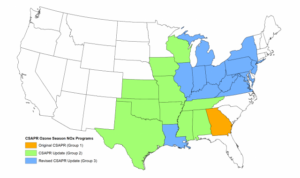Regulating Power Sector Carbon Emissions (original) (raw)
At-a-glance
- Twenty-five percent of U.S. greenhouse gas emissions come from generating electricity.
- EPA has authority under the Clean Air Act to monitor and regulate greenhouse gas emissions. The U.S. Supreme Court first confirmed this interpretation of the law in 2007.
- In April 2024, the U.S. Environmental Protection Agency (EPA) finalized carbon pollution standards for existing coal and new gas-fired plants. EPA announced the greenhouse gas rule for existing gas plants would take longer and will also cover criteria pollutants and air toxics.
Electric power generation is responsible for 25 percent of U.S. greenhouse gas emissions. These emissions come from burning coal or natural gas to make electricity. Greenhouse gas emissions from the power sector fell dramatically since their peak in 2005, but nonetheless represent a major source in the economy. Despite growing renewable generation, fossil fuels still account for about 60 percent of U.S. electricity.
Annual share of U.S. net electricity generation by source (1990 – 2023)

Clean Air Act
Multiple laws and court cases give the U.S. Environmental Protection Agency (EPA) the legal authority to monitor and regulate greenhouse gas emissions. Regulations were proposed (and most were finalized) after EPA’s authority to directly regulate greenhouse gas emissions under the Clean Air Act was clarified in the U.S. Supreme Court decision in Massachusetts v. EPA (2007).
EPA regulates greenhouse gas emissions from power plants under Section 111 of the Clean Air Act, which allows EPA and the states greater flexibility in crafting and implementing a standard.
In response to Executive Order 13990 on Protecting Public Health and the Environment and Restoring Science to Tackle the Climate Crisis, in May 2023, the EPA issued a proposed rule to limit carbon dioxide emissions from fossil fuel-fired power plants. The proposed rule would set carbon dioxide emission standards for existing coal and natural gas plants, and for new gas plants.
In April 2024, the U.S. Environmental Protection Agency (EPA) finalized multiple actions under Section 111 of the Clean Air Act. EPA finalized:
- the repeal of the Affordable Clean Energy (ACE) Rule
- emission guidelines for greenhouse gas emissions from existing fossil fuel-fired steam generating units
- revisions for greenhouse gas emissions from new fossil fuel-fired power plant
EPA did not finalize the rule for existing natural gas-fired power plants, and indicated they will take additional time to consider and develop a comprehensive approach to include criteria pollutants and air toxics.
Existing Power Plants
EPA has previously issued greenhouse gas regulations under Section 111(d) of the Clean Air Act for existing power plants, but these rules have not gone into effect. Section 111(d) allows EPA and the states greater flexibility in crafting and implementing a standard.
In April 2024, the U.S. Environmental Protection Agency (EPA) finalized greenhouse gas standards and guidelines for existing coal-fired steam generating units, and repealed the Affordable Clean Energy (ACE) Rule. These carbon pollution standards will be phased in over time and are based on how long these plants intend to operate to give plant operators adequate time to plan and install controls to limit carbon dioxide emissions.
- For units that plan to operate beyond 2038 (i.e., “long-term” units), the rule will effectively require installation and operation of carbon capture and storage (CCS) technology to achieve emission rate limits.
- For units that plan to retire before the end of 2038 (i.e., “medium-term” units), the rule recognizes that CCS would be less cost-effective and will have an emission rate limit based on co-firing with 40 percent natural gas, beginning in 2030.
- Units that plan to retire before 2032 are unaffected.
States will have the ability to provide an alternative standard for individual plants that have fundamentally different circumstances than those considered by EPA and that cannot reasonably achieve the required emission reductions.
EPA did not finalize the rule for existing natural gas-fired power plants, and indicated they will take additional time to consider and develop a comprehensive approach to include criteria pollutants and air toxics.
In May 2023, EPA proposed new greenhouse gas standards for existing coal and natural gas power plants, and would repeal the Affordable Clean Energy (ACE) Rule. Based on public comment and feedback, EPA made key changes from the proposed rule to: truncate the number of subcategories to “long-term” units and “medium-term” units, provide an application exemption for units that cease operations before 2032, and extend the compliance deadline for CCS-based standards to 2032 from 2030 (to match the same date as the rule for new power plants).
In January 2021, the U.S. Court of Appeals for the D.C. Circuit vacated the ACE Rule and remanded it to EPA. The appeals court ruled that EPA misinterpreted the Clean Air Act when crafting the ACE Rule as a means of regulating greenhouse gas emissions from power plants. The ACE rule was sent back to EPA, which finalized a new rule in April 2024 that includes repealing the ACE Rule.
The 2019 ACE Rule would have required existing coal-fired power plants to use prescribed technologies to improve their heat rate (i.e., increase efficiency), as a best system of emission reduction (BSER) for regulating carbon dioxide emissions. The ACE Rule was not expected to reduce power sector emissions. The ACE Rule was supposed to replace the 2015 Clean Power Plan, which set state-specific emission rates and provided various market-based flexible compliance provisions to reduce carbon dioxide emissions from existing power plants.
New Power Plants
EPA previously issued greenhouse gas regulations under Section 111(b) of the Clean Air Act, which applies to new, modified, and reconstructed power plants. Section 111(b) requires EPA to set numerical performance standards based on the best available technologies that have been adequately demonstrated.
In April 2024, the U.S. Environmental Protection Agency (EPA) finalized greenhouse gas standards and guidelines for new gas-fired combustion turbines. These carbon pollution standards will be phased in over time to give plant operators adequate time to plan and install controls to limit carbon dioxide emissions, and are based on how they are used.
- Base load turbines (units generating at least 40 percent of their maximum capacity on an annual basis) are subject to an initial “phase one” standard based on the efficient design and operations of combined cycle turbines; and “phase two” standards based on 90 percent CCS starting in 2032.
- Intermediate turbines (units generating between 20 and 40 percent of their maximum capacity on an annual basis) are subject to a standard based on the efficient design and operation of simple cycle turbines.
- Low load turbines (units generating less than 20 percent of their maximum capacity on an annual basis) are subject to a standard based on a low-emitting fuel.
In May 2023, EPA proposed greenhouse gas standards for power plants which included replacing the 2015 Carbon Pollution Standard for new, modified, and reconstructed gas plants. Based on public comment and feedback, EPA made key changes from the proposed rule to: expanded base load turbines to units operating above 40 percent capacity factor, moved the compliance deadline for CCS-based standards for base load units to 2032 from 2035 (to match the same date as the rule for coal plants), and removed hydrogen as a BSER.
In October 2015, EPA issued Carbon Pollution Standards for New Power Plants, which established New Source Performance Standards (NSPS) to limit carbon dioxide emissions from fossil fuel-fired power plants. In December 2018, EPA proposed revising the BSER determination for new coal-fired power plants as partial carbon capture and storage with a new determination that the best systems of emission reduction would be improvements in efficiency and operating practices. In January 2021, EPA issued a significant contribution finding for determining when standards are appropriate for greenhouse gas emissions from stationary sources under Section 111(b). In March 2021, EPA asked the D.C. Circuit to vacate and remand this rule since it was issued without public notice or an opportunity to comment. In April 2021, the D.C. Circuit vacated and remanded the rule back to EPA. The 2015 Carbon Pollution Standard for New Power Plants remains in effect.
Other Federal Regulations
Fossil fuel combustion at power plants emits other pollutants regulated by the Clean Air Act. Environmental controls on these other pollutants like SO2, NOx, and mercury often (though not always) result in greenhouse gas emission reductions. Other EPA rules on power plant air emissions include:
- The Cross-State Air Pollution Rule (CSAPR, pronounced “Casper”) covers the oxides from nitrogen (NOx) and sulfur dioxide (SO2) that create ozone and fine particulate matter (PM). Emissions of these pollutants from upwind states prevent downwind states from achieving air quality standards. CSAPR covers a few thousand sources in the Eastern part of the United States and employs tradable air permits to reduce emissions.

- The Mercury and Air Toxic Standards (MATS) rule limits emissions of mercury from coal and oil-fired power plants (natural gas does not contain mercury). Since the rule took effect in 2015, some coal-fired power plants have retired, but most operators chose instead to install control technology to reduce these emissions.
In April 2024, EPA finalized updates to revise the MATS rule to reflect recent developments in control technologies and the performance of these plants. EPA proposed to tighten the emissions limit for mercury for existing lignite-fired power plants by 70 percent, a level that is aligned with requirements other coal plants already have. The rule would also strengthen emissions monitoring and compliance.
EPA has separate authority under environmental laws to regulate power plant emissions and activities that have other harmful impacts, such as cooling water intakes and coal ash disposal.